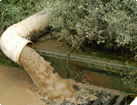Health and Safety
Taking care with materials, equipment and work procedures and dealing with hazards.
Sediment and run-off
If loose materials and bare soil on site are wet by heavy rain or large amounts of water from any other source, it may become run-off, which can enter and clog waterways, drains and the stormwater system. It may also be carried onto adjacent properties.
Run-off can also carry harmful waste such as paints and chemicals which will cause damage to wildlife in waterways, and clog water drainage systems.
On this page:
- preventing run-off
- sediment control
- pollution from concrete, asphalt and bitumen.
Preventing run-off
Methods of preventing soil erosion include:
- avoiding doing earthworks during the wet season
- using the natural ground contours to avoid earthworks if possible
- designing using poles or piles rather than excavations
- using tarpaulins or shotcrete to protect exposed soil
- removing the minimum amount of vegetation possible
- having one stabilised accessway onto the site only
- diverting any water away from earthworks and onto stable ground (e.g. grass, semi-permeable or paved), other than what falls on it as rain
- stabilising bare soil with mulch, paving, planting or grass as soon as possible
- controlling the flow of water with channels or contour drains.
Sediment control
Control sediment run-off with:
- vegetation
- silt fences to screen and filter sediment
- hay or straw bales to trap sediment
- sediment ponds.
Keep silt control devices clear and ensure that cleared material cannot run into waterways or drains.
Pollution from concrete, asphalt and bitumen
Concrete, asphalt and bitumen run-off can be damaging if it gets into waterways. It occurs when:
- new concrete, asphalt or bitumen is laid
- concrete pouring/laying equipment is washed
- concrete is waterblasted to expose aggregate.
Run-off from concrete, asphalt and bitumen must be contained on the site by:
- diverting onto onsite grass or soil
- containment in an appropriate storage tank if possible.
Updated: 04 September 2013


